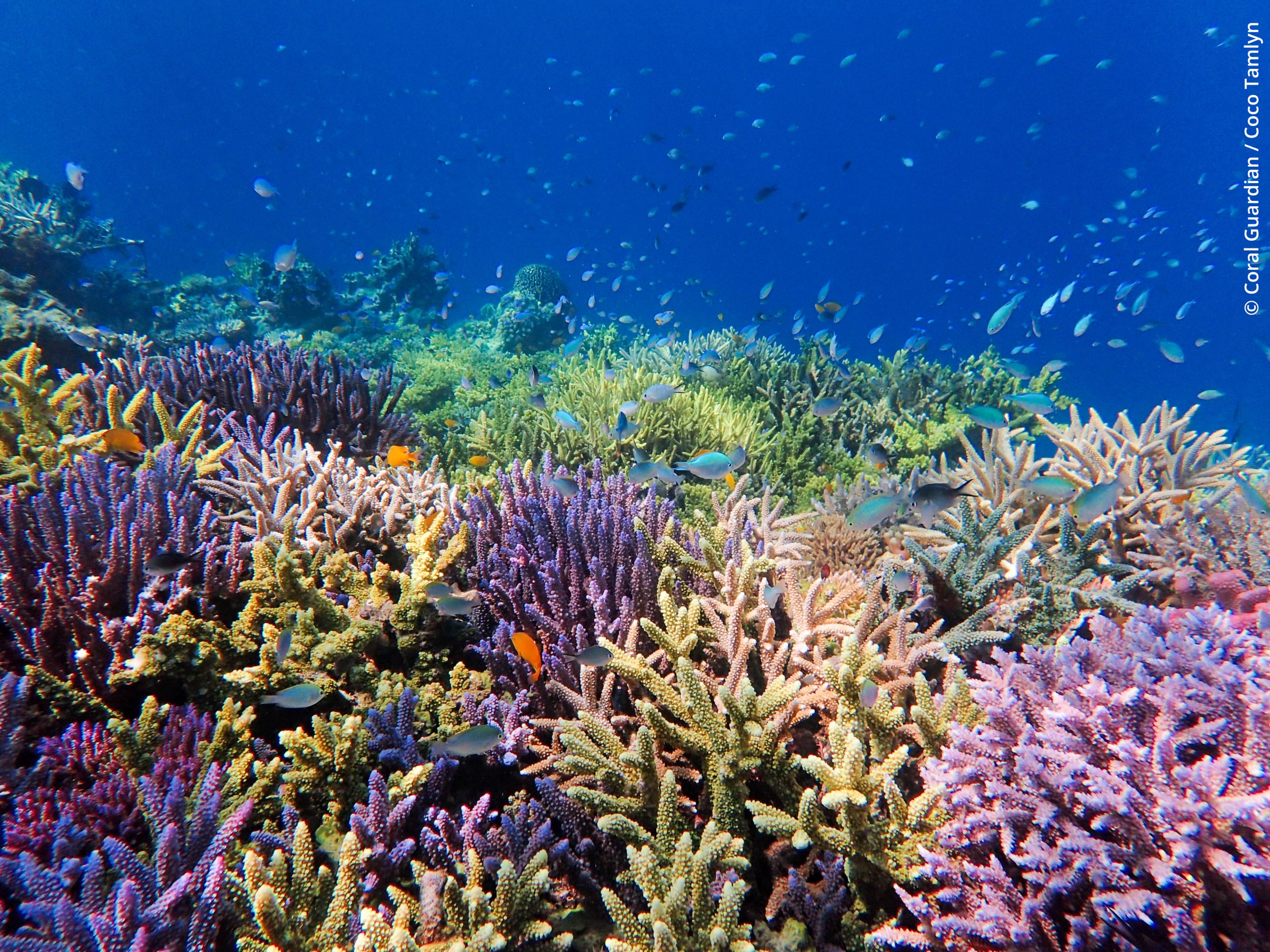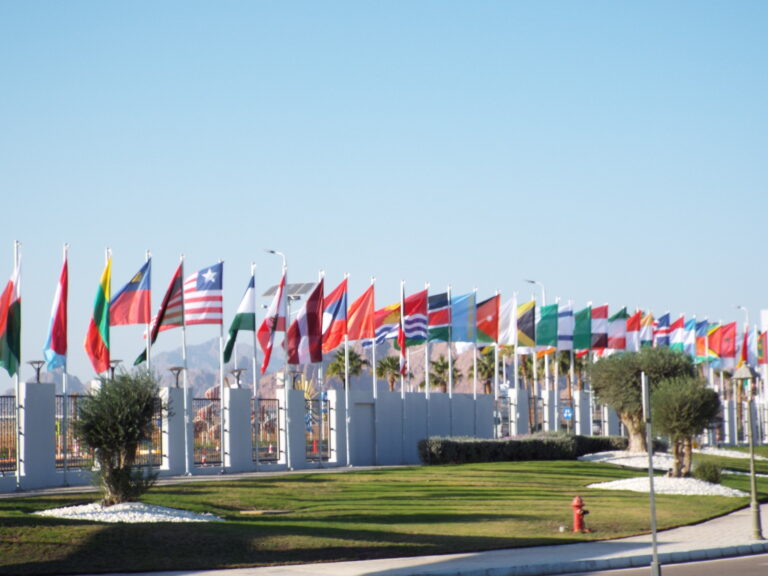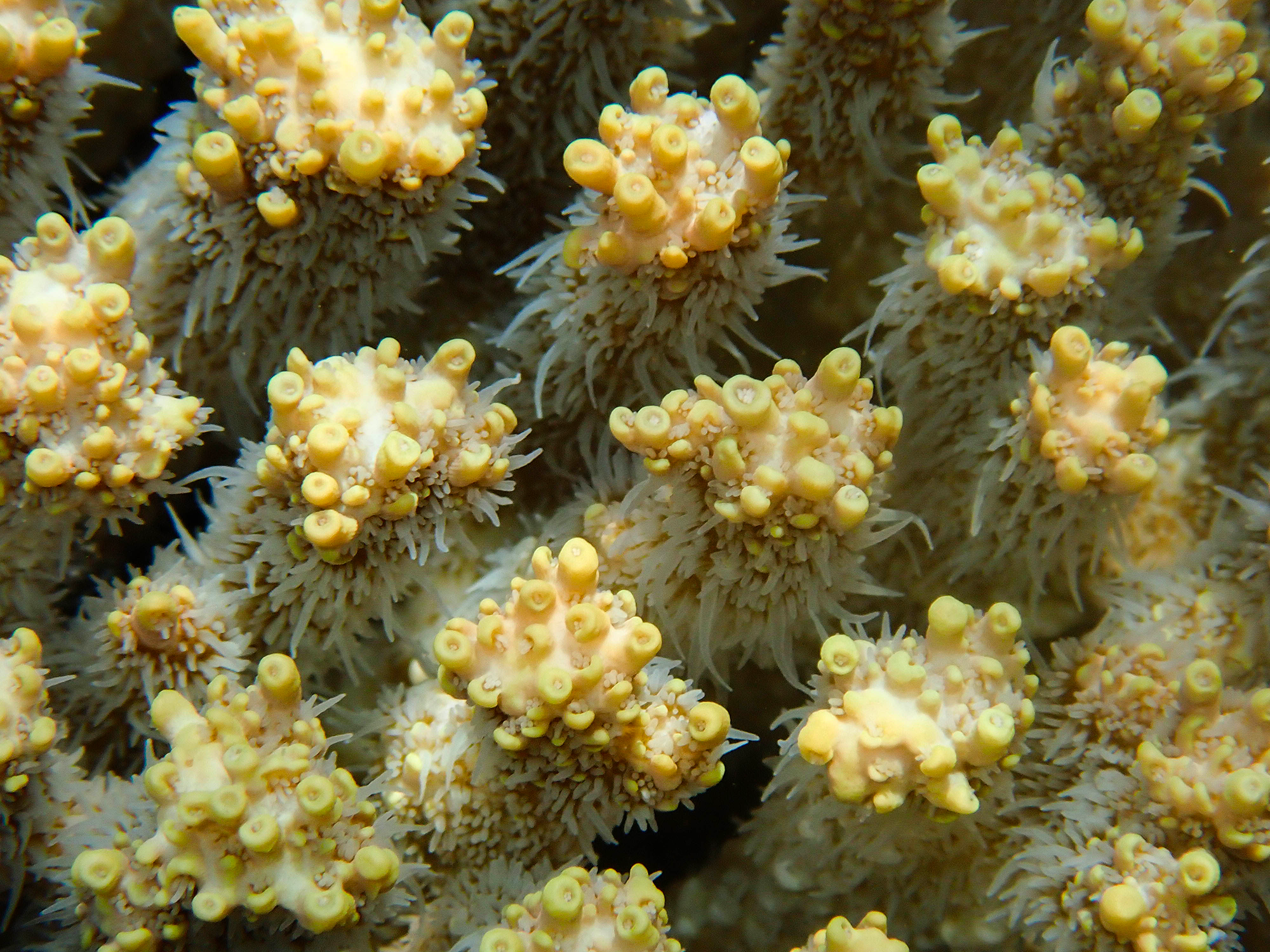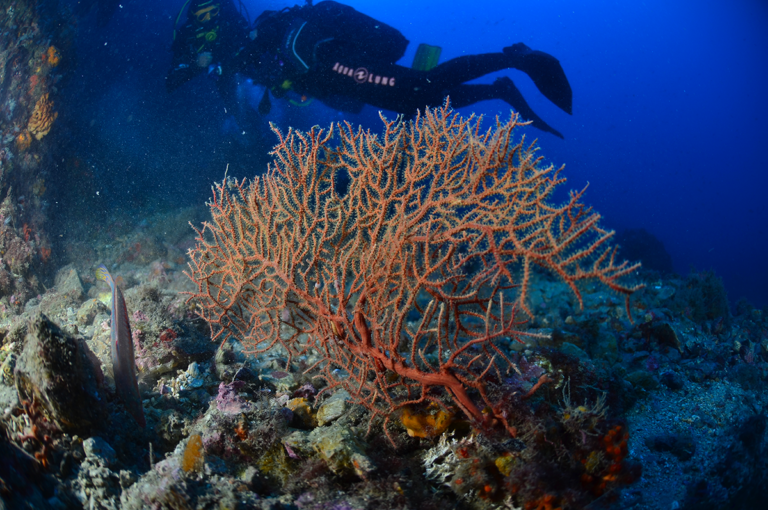Are super-corals really a super solution ?

Written by: Richard Singhroy
Acknowledgements to Dr. Emma Camp
While reefs are adaptable ecosystems, they are struggling to adapt to the quick changes brought on by man-made climate change, habitat destruction and overfishing (Eddy et al., 2021). Global coral reefs’ degradation calls for a variety of mitigation, adaptation, and conservation measures to cope with local, regional and global pressures. Among these measures, the use of super-corals for conservation purposes has been explored through research, propagation, outplant, relocation or protection. Research on “super-corals” is still being explored and a unique definition of the term is not yet available, as we have discussed in our previous article. Nevertheless, some scientists define super-coral as corals with superior tolerance/survivorship when exposed to one or more prolonged conditions (press) or severe events (pulse) considered “stressful” for most coral species (Camp et al., 2018a).
Finding “super-corals”
Some corals that can help bolster reefs are naturally occurring. An example of this is in the Gulf of Aqaba in the Red Sea. Here, coral communities’ species have been found to tolerate extreme temperature conditions: above 6 degrees their average summertime maximum for around three to four weeks (Fine et al., 2013). This is significant because most corals can only tolerate temperatures above 1 to 2 degrees above the average summertime maximum, and can only do so for 2 to 4 weeks (e.g.Hoegh-Guldberg, 2011). The species Stylophora pistillata, Pocillopora damicornis, and Favia favus have been found as prime candidates to be species of super-corals in the context of high temperatures and bleaching events due to this thermal tolerance (Grottoli et al., 2017).
Such tolerance has been suggested to be based on the genetic traits of the coral populations, resulting from the natural selection process over the coral larvae settled in the area (Fine et al., 2013; Grottoli et al., 2017). Only larvae tolerant to these extreme conditions on the species’ tolerance range were to survive and form the coral reef.
Microalgae resistance to heat strain and bleaching events
Taking this a step further, the thermal tolerance of corals can also be increased by improving the tolerance of symbiotic microalgae strains. Coral bleaching is heavily influenced by the strain of microalgae within the polyps (Buerger et al., 2020). Therefore, more resistant symbiotic algae can also help reduce the chance of bleaching. These algae also evolve far more rapidly than the coral host itself (Chakravarti & van Oppen, 2018). This makes them easier to select for in laboratory conditions. Scientists expect that these heat and bleaching-resistant strains can then be introduced to an ecosystem where corals can host them. The results of this research have been promising with some experiments seeing the continued growth of the symbiotic algae during thermal stress (Chakravarti & van Oppen, 2018).
Application of super-corals
Evidence supports that identifying and introducing heat-tolerant corals to a reef can increase the overall tolerance of corals to heat stress, as well as the ability of the reef to recover from stressful events (Morikawa & Palumbi, 2019). The biodiversity of the ecosystem is an important asset for reefs to endure bleaching events, this is equally true for the diversity of coral species as it is for the microbiome (Gardner et al., 2019).
The timing of the introduction of super-corals or microalgae can also be important for recovering from thermal stress. Some studies have found that the introduction of resistant symbiotic microalgae is most effective right after a bleaching event so that bleached corals may recover by taking in the resistant algae (Silverstein et al., 2015). It was found that the corals that were bleached, and exposed to resistant microalgae after, were better able to endure high temperatures later (Silverstein et al., 2015).
In addition to introducing super-corals to maintain reef health, there are some locations where corals survive better than in the surrounding reefs, called refuges, refugia, and hope spots, amongst other terms (Camp, 2022). Here, conditions are maintained favourable for corals when lost elsewhere. Management and protection of such locations are critical in maintaining regional reef health, as corals in such areas are sheltered from stress present in surrounding areas and can therefore persist and eventually repopulate areas that have been decimated by changing environmental conditions (see Camp, 2022).
What are limitations to super-corals?
There are however precautions and considerations when using super-corals for conservation purposes. Amongst them, first, to acknowledge that corals with enhanced tolerance to one stressor, such as thermal stress, may not be resistant to other stressors, such as low pH (Camp et al, 2018a). In the same way, that pulse stress-resistant corals might not be resistant to press events (Camp et al, 2018a). So, when using super-corals for conservation, an important step would be to identify under what environmental conditions it can operate and how it can perform under future changing conditions.
Second, super-corals have reported energetic trade-offs (see review by Camp et al, 2018b): higher thermal tolerance can be accompanied by a reduction in growth rate. So it must be considered how may ecosystem services supply change with the introduction of super-coral to reefs?
Conclusions
Despite the advances in this field, coral reefs remain among the most threatened ecosystems. Super-corals can be a potential tool in the fight to preserve or restore coral ecosystems. They can contribute to our understanding of the mechanisms of coral survival under different stress, as well as a wide range of applications for conservation strategies (see Camp, 2022). But limitations of super-corals should not be overlooked, and their feasibility should be assessed before implementation. To save our coral ecosystems we need to use all the tools at our disposal at a regional and local level. And of course, the elephant in the room worldwide is climate change, and our urgency to reduce CO2 emissions. As with all conservation efforts, the use of super-corals should not be implemented in isolation and must be considered carefully, yet they remain a powerful tool to ensure the future of coral reefs.
Cited literature
Buerger, P., Alvarez-Roa, C., Coppin, C. W., Pearce, S. L., Chakravarti, L. J., Oakeshott, J. G., Edwards, O. R., & van Oppen, M. J. H. (2020). Heat-evolved microalgal symbionts increase coral bleaching tolerance. Science Advances, 6(20), eaba2498. https://doi.org/10.1126/sciadv.aba2498
Camp E.F., Schoepf V., Suggett D.J. (2018a). How can “Super Corals” facilitate global coral reef survival under rapid environmental and climatic change? Glob Chang Biol. Jul;24(7):2755-2757. doi: 10.1111/gcb.14153. Epub 2018 Apr 27. PMID: 29582529.
Camp E.F., Schoepf V., Mumby P.J., Hardtke L.A., Rodolfo-Metalpa R., Smith D.J. Suggett D.J. (2018b) The Future of Coral Reefs Subject to Rapid Climate Change: Lessons from Natural Extreme Environments. Front. Mar. Sci. 5:4. doi: 10.3389/fmars.2018.00004
Camp, E. F. (2022). Contingency planning for coral reefs in the Anthropocene; The potential of reef safe havens. Emerging Topics in Life Sciences, 6(1), 107–124. https://doi.org/10.1042/ETLS20210232
Chakravarti, L. J., & van Oppen, M. J. H. (2018). Experimental Evolution in Coral Photosymbionts as a Tool to Increase Thermal Tolerance. Frontiers in Marine Science, 5. https://www.frontiersin.org/articles/10.3389/fmars.2018.00227
Eddy, T. D., Lam, V. W. Y., Reygondeau, G., Cisneros-Montemayor, A. M., Greer, K., Palomares, M. L. D., Bruno, J. F., Ota, Y., & Cheung, W. W. L. (2021). Global decline in capacity of coral reefs to provide ecosystem services. One Earth, 4(9), 1278–1285. https://doi.org/10.1016/j.oneear.2021.08.016
Fine, M., Gildor, H., & Genin, A. (2013). A coral reef refuge in the Red Sea. Global Change Biology, 19(12), 3640–3647. https://doi.org/10.1111/gcb.12356
Gardner, S. G., Camp, E. F., Smith, D. J., Kahlke, T., Osman, E. O., Gendron, G., Hume, B. C. C., Pogoreutz, C., Voolstra, C. R., & Suggett, D. J. (2019). Coral microbiome diversity reflects mass coral bleaching susceptibility during the 2016 El Niño heat wave. Ecology and Evolution, 9(3), 938–956. https://doi.org/10.1002/ece3.4662
Goreau, T. J. F., & Hayes, R. L. (2005). GLOBAL CORAL REEF BLEACHING AND SEA SURFACE TEMPERATURE TRENDS FROM SATELLITE-DERIVED HOTSPOT ANALYSIS. 17(2), 40.
Grottoli, A. G., Tchernov, D., & Winters, G. (2017). Physiological and Biogeochemical Responses of Super-Corals to Thermal Stress from the Northern Gulf of Aqaba, Red Sea. Frontiers in Marine Science, 4. https://www.frontiersin.org/article/10.3389/fmars.2017.0021
Hoegh-Guldberg, O. (2011). The Impact of Climate Change on Coral Reef Ecosystems. In Z. Dubinsky & N. Stambler (Eds.), Coral Reefs: An Ecosystem in Transition (pp. 391–403). Springer Netherlands. https://doi.org/10.1007/978-94-007-0114-4_22
Kleypas, J., Allemand, D., Anthony, K., Baker, A. C., Beck, M. W., Hale, L. Z., Hilmi, N., Hoegh-Guldberg, O., Hughes, T., Kaufman, L., Kayanne, H., Magnan, A. K., Mcleod, E., Mumby, P., Palumbi, S., Richmond, R. H., Rinkevich, B., Steneck, R. S., Voolstra, C. R., … Gattuso, J.-P. (2021). Designing a blueprint for coral reef survival. Biological Conservation, 257, 109107. https://doi.org/10.1016/j.biocon.2021.109107
Knowlton, N. (2001). The future of coral reefs. Proceedings of the National Academy of Sciences, 98(10), 5419–5425. https://doi.org/10.1073/pnas.091092998
Morikawa, M. K., & Palumbi, S. R. (2019). Using naturally occurring climate resilient corals to construct bleaching-resistant nurseries. Proceedings of the National Academy of Sciences, 116(21), 10586–10591. https://doi.org/10.1073/pnas.1721415116
Silverstein, R. N., Cunning, R., & Baker, A. C. (2015). Change in algal symbiont communities after bleaching, not prior heat exposure, increases heat tolerance of reef corals. Global Change Biology, 21(1), 236–249. https://doi.org/10.1111/gcb.12706
Ces articles pourraient vous intéresser

Donor spotlight : Charline Auvinet
Tell us a bit about yourself 🙂 After graduating a few years ago, I’m now a crime fiction editor. In this job, I have discovered…
17 January 2023
What about the impact of COP27 on marine biodiversity and corals?
Every year, the United Nations holds a two-week conference (COP, as Conference of the Parties) aimed specifically at taking stock of global progress made towards…
14 December 2022
Super corals, a not-so-super term?
Written by: Richard Singhroy Acknowledgement to Dr. Emma Camp From the deep sea to the arctic frontier and tropical coastlines, corals have formed the…
22 September 2022
How is the increase in water temperature threatening marine biodiversity in the Mediterranean?
Written by: Vincent Diringer Acknowledgments to Joaquim Garrabou When it comes to rising sea temperatures and its effect on marine biodiversity, Australia’s Great Barrier…
24 August 2022
